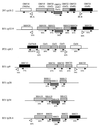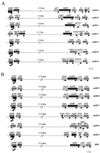Molecular and evolutionary characterization of the cp32/18 family of supercoiled plasmids in Borrelia burgdorferi 297
- PMID: 10678977
- PMCID: PMC97318
- DOI: 10.1128/IAI.68.3.1574-1586.2000
Molecular and evolutionary characterization of the cp32/18 family of supercoiled plasmids in Borrelia burgdorferi 297
Abstract
In this study, we characterized seven members of the cp32/18 family of supercoiled plasmids in Borrelia burgdorferi 297. Complete sequence analysis of a 21-kb plasmid (cp18-2) confirmed that the strain 297 plasmids are similar in overall content and organization to their B31 counterparts. Of the 31 open reading frames (ORFs) in cp18-2, only three showed sequence relatedness to proteins with known functions, and only one, a ParA/SopA ortholog, was related to nonborrelial polypeptides. Besides the lipoproteins, none of the ORFs appeared likely to encode a surface-exposed protein. Comparison with the B31 genomic sequence indicated that paralogs for most of the ORFs in cp18-2 can be identified on other genetic elements. cp18-2 was found to lack a 9- to 10-kb fragment present in the 32-kb homologs which, by extrapolation from the B31 cp32 sequences, contains at least 15 genes presumed to be unnecessary for plasmid maintenance. Sequence analysis of the lipoprotein-encoding variable loci provided evidence that recombinatorial processes within these regions may result in the acquisition of exogenous DNA. Pairwise analysis with random shuffling revealed that the multiple lipoproteins (Mlp; formerly designated 2.9 LPs) fall into two distinct homology groups which appear to have arisen by gene fusion events similar to those recently proposed to have generated the three OspE, OspF, and Elp lipoprotein families (D. R. Akins, M. J. Caimano, X. Yang, F. Cerna, M. V. Norgard, and J. D. Radolf, Infect. Immun. 67:1526-1532, 1999). Comparative analysis of the variable regions also indicated that recombination within the loci of each plasmid may occur independently. Last, comparison of variable loci revealed that the cp32/18 plasmid complements of the B31 and 297 isolates differ substantially, indicating that the two strains have been subject to divergent adaptive pressures. In addition to providing evidence for two different types of recombinatorial events involving cp32/18 plasmids, these findings underscore the need for genetic analysis of diverse borrelial isolates in order to elucidate the Lyme disease spirochete's complex parasitic strategies.
Figures







Similar articles
-
Molecular and evolutionary analysis of Borrelia burgdorferi 297 circular plasmid-encoded lipoproteins with OspE- and OspF-like leader peptides.Infect Immun. 1999 Mar;67(3):1526-32. doi: 10.1128/IAI.67.3.1526-1532.1999. Infect Immun. 1999. PMID: 10024606 Free PMC article.
-
Characterization of cp18, a naturally truncated member of the cp32 family of Borrelia burgdorferi plasmids.J Bacteriol. 1997 Jul;179(13):4285-91. doi: 10.1128/jb.179.13.4285-4291.1997. J Bacteriol. 1997. PMID: 9209045 Free PMC article.
-
Repetition, conservation, and variation: the multiple cp32 plasmids of Borrelia species.J Mol Microbiol Biotechnol. 2000 Oct;2(4):411-22. J Mol Microbiol Biotechnol. 2000. PMID: 11075913 Review.
-
The relapsing fever spirochete Borrelia hermsii contains multiple, antigen-encoding circular plasmids that are homologous to the cp32 plasmids of Lyme disease spirochetes.Infect Immun. 2000 Jul;68(7):3900-8. doi: 10.1128/IAI.68.7.3900-3908.2000. Infect Immun. 2000. PMID: 10858201 Free PMC article.
-
Borrelia genomes in the year 2000.J Mol Microbiol Biotechnol. 2000 Oct;2(4):401-10. J Mol Microbiol Biotechnol. 2000. PMID: 11075912 Review.
Cited by
-
Intra- and interbacterial genetic exchange of Lyme disease spirochete erp genes generates sequence identity amidst diversity.J Mol Evol. 2003 Sep;57(3):309-24. doi: 10.1007/s00239-003-2482-x. J Mol Evol. 2003. PMID: 14629041
-
Lyme arthritis resolution with antiserum to a 37-kilodalton Borrelia burgdorferi protein.Infect Immun. 2000 Jul;68(7):4169-73. doi: 10.1128/IAI.68.7.4169-4173.2000. Infect Immun. 2000. PMID: 10858233 Free PMC article.
-
Expression and immunological analysis of the plasmid-borne mlp genes of Borrelia burgdorferi strain B31.Infect Immun. 2000 Sep;68(9):4992-5001. doi: 10.1128/IAI.68.9.4992-5001.2000. Infect Immun. 2000. PMID: 10948116 Free PMC article.
-
Telomere exchange between linear replicons of Borrelia burgdorferi.J Bacteriol. 2004 Jul;186(13):4134-41. doi: 10.1128/JB.186.13.4134-4141.2004. J Bacteriol. 2004. PMID: 15205414 Free PMC article.
-
Genetics of Borrelia burgdorferi.Annu Rev Genet. 2012;46:515-36. doi: 10.1146/annurev-genet-011112-112140. Epub 2012 Sep 4. Annu Rev Genet. 2012. PMID: 22974303 Free PMC article. Review.
References
-
- Akins D R, Porcella S F, Popova T G, Shevchenko D, Baker S I, Li M, Norgard M V, Radolf J D. Evidence for in vivo but not in vitro expression of a Borrelia burgdorferi outer surface protein F (OspF) homolog. Mol Microbiol. 1995;18:507–520. - PubMed
-
- Baranton G, Postic D, Saint Girons I, Boerlin P, Piffaretti J C, Assous M, Grimont P A. Delineation of Borrelia burgdorferi sensu stricto, Borrelia garinii sp. nov. and group VS461 associated with Lyme borreliosis. Int J Syst Bacteriol. 1992;42:378–383. - PubMed
Publication types
MeSH terms
Grants and funding
LinkOut - more resources
Full Text Sources

